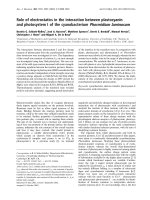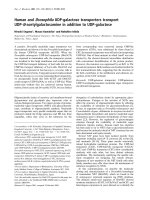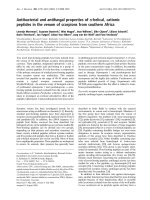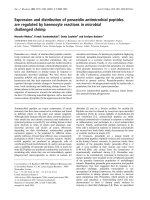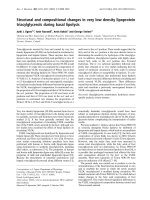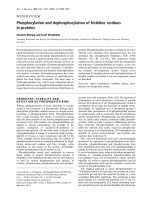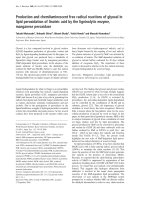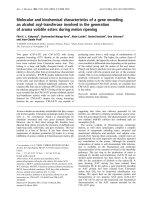Báo cáo y học: " Medicine and psychiatry in Western culture: Ancient Greek myths and modern prejudices" doc
Bạn đang xem bản rút gọn của tài liệu. Xem và tải ngay bản đầy đủ của tài liệu tại đây (202 KB, 8 trang )
BioMed Central
Page 1 of 8
(page number not for citation purposes)
Annals of General Psychiatry
Open Access
Review
Medicine and psychiatry in Western culture: Ancient Greek myths
and modern prejudices
Michele Fornaro*
1
, Nicoletta Clementi
2
and Pantaleo Fornaro
1
Address:
1
Dipartimento di Psichiatria, Università di Genova, Genoa, Italy and
2
Psychopharmacology Unit, Bristol University, UK
Email: Michele Fornaro* - ; Nicoletta Clementi - ;
Pantaleo Fornaro -
* Corresponding author
Abstract
The origins of Western culture extensively relate to Ancient Greek culture. While many ancient
cultures have contributed to our current knowledge about medicine and the origins of psychiatry,
the Ancient Greeks were among the best observers of feelings and moods patients expressed
towards medicine and toward what today is referred to as 'psychopathology'. Myths and religious
references were used to explain what was otherwise impossible to understand or be easily
communicated. Most ancient myths focus on ambiguous feelings patients may have had towards
drugs, especially psychotropic ones. Interestingly, such prejudices are common even today.
Recalling ancient findings and descriptions made using myths could represent a valuable knowledge
base for modern physicians, especially for psychiatrists and their patients, with the aim of better
understanding each other and therefore achieving a better clinical outcome. This paper explores
many human aspects and feelings towards doctors and their cures, referring to ancient myths and
focusing on the perception of mental illness.
Background
The origins of Western culture are extensively related to
Ancient Greek culture, and many current aspects of
human behaviour and social organisation still rely on
these roots. This observation, having relevant implica-
tions for the whole of medical practice and therefore for
psychiatry too, is hardly ever recalled, even among well
educated people (as physicians are expected to be). As a
consequence, many aspects of human life, such as fear,
pain, convictions, expectations and prejudices against
medicine (especially the ones against psychiatry and its
practitioners), illness and death today seem quite disre-
garded. Nevertheless, such human aspects, already exten-
sively investigated many centuries ago by different
cultures, are often applied to mythology, leading to
understandings still relevant in modern times.
The honourable, yet too often disregarded, Confucius's
(551 to 479 BCE) quote 'study the past if you would
divine the future' perfectly applies to the above-men-
tioned scenario, reminding us that concepts and observa-
tions from different ages and cultures may be equally true
even among different cultures of heterogeneous origins
and chronological settings.
From a medical and clinical psychiatric perspective,
Ancient Greek culture and myths represent a valuable pro-
totype for greater comprehension of our modern practice,
Published: 7 October 2009
Annals of General Psychiatry 2009, 8:21 doi:10.1186/1744-859X-8-21
Received: 7 July 2009
Accepted: 7 October 2009
This article is available from: />© 2009 Fornaro et al; licensee BioMed Central Ltd.
This is an Open Access article distributed under the terms of the Creative Commons Attribution License ( />),
which permits unrestricted use, distribution, and reproduction in any medium, provided the original work is properly cited.
Annals of General Psychiatry 2009, 8:21 />Page 2 of 8
(page number not for citation purposes)
with the aim of instigating better clinical compliance,
treatment adherence and outcomes.
Stigmatisation, myths and prejudices against
mental illness
Prejudice and discrimination against mental illness have
been reported since ancient times, while both somatic and
non-somatic illnesses were traditionally considered as a
sort of 'punishment' for a guilty patient. The Ancient
Greek word 'aítia' ('guilty', 'responsibility'), also links
with the beginning of the word 'aetiology' and other med-
ically related words as well. Prejudices against mental ill-
ness had further developed by the period from the Middle
Ages to the 17th century, when the French physician Per-
dulcis (1545 to 1611) first introduced psychiatric nosol-
ogy describing clinical pictures as 'demonopatia mania'
and 'demonic possession' provoked by the blending of
'evil spirit' with 'Hippocratic humors' [1].
An example of such an approach to mental illness is the
one provided by hysteria, whose somatic anaesthesia, in
the sense of pain relief, was considered to be due to
demonic interventions until the late 17th century, before
being though of as an illness, yet it is still seen today in a
detrimental way, since seldom identified as a factitious
disorder [2].
Today, magical interpretations, myths and prejudices
against mental illness are not uncommon, often leading
to clinical worsening of the patient's conditions with
resulting loss of self-esteem, fear, social retirement and
acting out among other issues.
High failure rates in early recognition of depression have
been reported among general practitioners, possibly due
to a prevalence of somatic presentation at onset. Indeed,
somatic symptoms are 'easier' and quicker to be diag-
nosed and to be 'accepted', and this is probably why many
patients (usually 'unconsciously') exhibit such manifesta-
tions instead of non-somatic, 'masked', ones.
A 'masked depression', defined as one with almost exclu-
sively somatic presentations, is often reported among spe-
cific populations or social conditions as an expression of
the 'pathoplastic' effect of culture [3]. As a consequence,
delay in adequate treatment can often provoke further
impairment and lead to a poorer outcome.
Stigma and prejudice against mental illness, though still
far from being a thing of the past, has been progressively
addressed in the media and by various organisations. For
example, the National Alliance on Mental Illness (NAMI)
counts more than 185,000 members in USA involved in
spreading greater knowledge of the clinical and social
phenomenon of mental illness. NAMI also cooperates
with the American Psychiatric Association (APA) in pursu-
ing the goal of introducing acts overcoming social and
employment laws that are discriminatory to the mental
ill.
Similar objectives are the ones the World Health Organi-
zation (WHO) is pursuing along with many others socie-
ties and organisations among different countries. In the
UK, the 'Changing Minds Stigma Campaign' introduced
in 1997 by the Royal College of Psychiatrists had the aim
of spreading knowledge about the phenomenon of men-
tal illness among the general population, while the World
Psychiatric Association (WPA) mainly focuses on reduc-
ing stigma against schizophrenia.
The above-mentioned organisations and societies, and
many others besides, also focus on reducing stigma
against psychotropic drugs, as they usually represent the
core therapy to treat psychiatric conditions. In fact, most
discrimination and fear related to psychiatric drugs is due
to the potential side effects common to first generation
treatments.
For example, typical antipsychotics, an effective and valu-
able class of drugs, have been repeatedly reported to
potentially induce extrapyramidal syndrome (EPS), tar-
dive dyskinaesia (TD) and other side effects [4], while
newly introduced, safer yet still effective atypical antipsy-
chotics are still not as 'popular' in the media or as well
known by patients [5], especially in Europe and Australia
compared to USA.
Further complicating the perception patients and the gen-
eral population have of psychiatric disorders is the fact
that in most cases psychiatric conditions can manifest
with heterogeneous clinical pictures during the lifespan of
the patient [6].
Sleep disturbances, motor retardation or agitation and
cognition impairments, as many other symptoms, could
precede a 'full threshold' disorder or represent a residual
one, possibly due to a partial remission and/or an abrupt
interruption of pharmacotherapy, leading to a poorer
quality of life and further increasing social and interper-
sonal problems [7].
Mythology, medicine or both?
Elephants and pigs have long been observed to enjoy the
effects of alcohol obtained by eating fallen mangoes or
apples that are fermenting. It seems like our ancestors
observed and copied the behaviour of such animals and
then, being human and having the ability to think and
create, developed methods to ensure a continuous alcohol
supply. One assumes that the survival value of such a
process was then, as now is, the desire for temporary
escape from the human condition.
Annals of General Psychiatry 2009, 8:21 />Page 3 of 8
(page number not for citation purposes)
Natural psychotropic substances obtained from plants
including tobacco, cannabis, opium, coffee and others
provided the needed escape, constituting the so-called
'pre-alcoholic era'.
Both recreational and therapeutic uses for natural
resources were pursued at the same time. Looking to their
close environment, human beings did not distinguish
between substances aimed at treating illness or alleviating
pain. Indeed, both purposes were originally considered as
indivisible needs and only later were they considered sep-
arately. Moreover, somatic and psychic illnesses were ini-
tially seen as part of the same whole, therefore being
treated using the same substances as well.
Psychic and somatic symptoms were considered as sepa-
rated phenomena only in later times, before finally being
progressively considered once more as different manifes-
tations affecting the 'same body' in the course of the 'same
disease'.
Rather than looking for remedies from environmental
sources, the human need to search for a cure for pain, ill-
ness and death has been addressed by looking to the
supernatural and magic. Unsurprisingly, the word 'rem-
edy' derives from the Latin verb 'mederi', which resembles
the Latin origin of the word 'medicine' as well. In fact, the
main goal of medicine is to provide a cure for pain and ill-
ness, independently of the source.
Ancient Greek medicine was a complex practice perceived
as something between myth and reality, as an expression
of a magical divinatory, hieratic and empirical technical
practice. Consequently, ancient medicine is tightly linked
with ancient mythology.
An example of such overlap is the one provided by the
myth of Asclepius, considered, quoting Pindar (522 to
443 BCE), to be 'the god of medicine' by Ancient Greeks
[8].
According to the myth, Asclepius, son of the god Apollo
and the nymph Coronis, was born from by the dead body
of his mother, an unfaithful wife executed by the goddess
Artemis, twin sister of Apollo. This has been considered as
the first Caesarean birth delivered from a dead mother.
Asclepius was raised by Chiron, a centaur, again an over-
lap between myth and medical knowledge, considered as
the master of medical practice and herbal medicines.
Soon the pupil surpassed his master, becoming the 'god of
medicine'.
Homer (circa 8th century BCE) also reports Asclepius as
being the first to distinguish between medicine and sur-
gery: he gave the power of recovery to his son Podalirius
and the ability to treat wounds to Machaon; interestingly,
no separation between psychic and somatic conditions
was made [9].
Most ancient myths were routinely related to everyday life
events. Over 200 temples to Asclepius's were built within
the Hellades, representing the first known hospitals. The
patients were allowed to rest and to sleep close to the
arcades where prophetic dreams took place, probably
induced by the unwitting consumption of drugs. During
such dreams, they believed they could feel the presence of
Asclepius providing them with therapeutic tips and the
ability to recovery. In fact, the wizard doctors, dressed up
as gods, were the ones giving poisons to the patients at
night.
Temples had long been considered the preferred setting
for magical and medical rituals, and animals were a fre-
quent presence during such ceremonies. The mythological
character of Coronis, the mother of the god of medicine,
is also related to the therapeutic ritual performed at the
sacred temple of Athena. The name Coronis is derived
from the Ancient Greek word 'corònos' meaning 'crows',
considered as being related to an ancient diagnostic and
therapeutic ritual performed to divine the future. During
this practice it was possible to attend to the reincarnation
of heroes as ravens or snakes by the intervention of the
goddess Athena, also known as the 'mistletoe user'.
Harvesting mistletoe growing over oak branches retained
the symbolic meaning of castrating the host tree because
the juice from mistletoe berries, seen as the 'oak sperm'
(mistletoe was called 'viscum album' in Latin, maybe due
to its sperm-like features) was considered to be charged
with regenerative powers and therapeutic properties [10].
The word 'mistletoe' is related to the Latin name of the
god of medicine, Asclepius, as well, meaning 'what is
hanging from the edible oak', or 'esculent', that is to say
'good to be eaten', as mistletoe also means.
It is curious to note that among different civilizations and
in different ages, the same substances were used with sim-
ilar purposes while today most of these significances are
all but forgotten. For example, the Celts considered mis-
tletoe sacred too, using it in many religious rituals. This
plant was also widely used as a remedy during the Middle
Ages and the Renaissance, while by the second half of the
19th into the first decades of the 20th century it was being
prescribed for its antihypertensive properties. Today, it
just has a symbolic value at Christmas.
Mistletoe is just one among many different herbs and
trees used in ancient medical practice; the bark of willow
trees surrounding the temple of Athena contained sali-
cylate, an antipyretic and anti-inflammatory drug still
Annals of General Psychiatry 2009, 8:21 />Page 4 of 8
(page number not for citation purposes)
widely prescribed by modern physicians (today known to
be able to interact with reactive proinflammatory C-pro-
tein).
Independently of the myths used to explain medical ill-
nesses and their management, overlaps between legend,
religion and medicine had long been widespread among
Ancient Greeks until Hippocrates (460 to 377 BCE) first
distinguished such entities.
Hippocrates introduced a more modern-like model of
depression. He applied the concepts of his essential 'the-
ory of four humors and temperaments' to melancholia
('mélaina' means 'black' while 'cholé' is 'bile'), described
as a consequence of an imbalance of the four essential flu-
ids influencing both physical and psychic manifestations.
These fluids ('humors') were blood, phlegm, black bile
and yellow bile.
As for psychic disorders, the fluid theory was equally valid
for somatic manifestations too. According to Hippocratic
theory, an imbalance in fluid proportions was considered
responsible for a peculiar temperament, possibly leading
to severe depression, while a healthy subject, the 'good
humor' man, has the four humors in appropriate propor-
tions. Depression and other psychiatric conditions were
therefore considered organic disorders.
Modern doctors know that in the course of pancreatic can-
cer most patients experience severe 'melancholic' depres-
sion, almost indistinguishable from primary depression;
ancient doctors had already noted this clinical phenome-
non, and this is probably why the pancreas was consid-
ered the inner site of black bile.
Using the above-mentioned theory, Hippocrates was also
the first to describe possible seasonal courses of 'mood' or
'humor' disorders [11]. Most Hippocratic observations
represented innovative progresses in the medical field.
Yet, they were generally disregarded or 'misunderstood'
during the ages that followed, when myth (or religion)
influenced the medical and scientific approach.
Poisons and remedies
'Doctors are men who prescribe medicines of which they
know little, to cure diseases of which they know less, in
human beings of whom they know nothing' (Voltaire,
1694 to 1778).
Most clinicians know from their everyday practice that a
great number of patients show mistrust towards suggested
drugs, especially for treatments prescribed to them for the
first time and/or by physicians they have not met previ-
ously or do not know well or trust. This is probably due to
a lack of knowledge and seems to be particularly true in
modern psychiatry, which bases most of its therapeutic
interventions on the pharmacologic approach.
Patients could perceive drugs aimed at treating their 'inner
psychic pain' as 'mysterious' and/or 'unnatural' things.
While today the impact of somatic pain and disease is
accepted almost everywhere, this is not always true for
psychiatric conditions, although possibly manifesting
with somatic symptoms as well [12]. In other words, the
physical pain reported by some psychiatric patients
should be more often go disregarded compared the one
reported by "non psychiatric patients"; in many cultures,
this may have contributed the somatic expression of psy-
chiatric symptomatology to be a "more acceptable" way to
communicate the experienced pain.
Again, looking back to Ancient Greek mythology, it is easy
to find many explanations for this kind of mentality, prej-
udice and concern against the 'doctor and his drugs',
which in most cases is still far from being completely over-
come even today.
The etymology of the word 'pharmacology' has different
meanings. The Ancient Greek word 'phàrmakon' means
'poison' or 'drug', but also means 'lucky charm'. In fact,
the 'drug', as a 'poison', is a substance that could lead to
the patient's death or, as with a magic 'amulet', it could
'magically' lead to their recovery.
The ambivalence patients experienced towards doctors
and their cures has been described in many Ancient Greek
myths. One famous Greek myth is that of the Zeus oracle
Trophonios, situated in a cavern in the Lebadeia village in
the region of Boiotia.
According to the myth, Trophonios was also a sort of 'wiz-
ard doctor', able to change the given temperament of a
subject to one of an opposite polarity. Patients, most
likely catatonic depressed ones, were taken into his pres-
ence with the aim of making them recover from severe ill-
ness [9]. Curiously, the Novartis trade name for the
tricyclic antidepressant molecule imipramine is 'Tofranil',
referring to a hoped immediate improvement in the
mood of depressed patients.
Most Ancient Greek myths were also adopted by later civ-
ilizations. Ancient Roman coins represented Janus Bifrons
as a frightening ugly character with two bearded faces
looking in opposite directions (a double-headed character
had already appeared on Greek coins in Amphipolis and
Thessalonica) [9]. The 'double-face' profile of the charac-
ter and the two opposite possible outcomes of the 'ther-
apy', perfectly resemble the concept of ambivalence
toward medicine and its practitioners.
Annals of General Psychiatry 2009, 8:21 />Page 5 of 8
(page number not for citation purposes)
One of the most curious aspects of Ancient Greek mythol-
ogy is that in most cases the same myth, based on a rela-
tively simple structure, is used to 'explain' different (often
complex) concepts not elsewhere understood. This
applies to complicated concepts and life events experi-
enced by the patient, such as pain, illness and death.
Again, referring to the myth of Asclepius, it includes ele-
ments closely associated with the magical and irrational
aspects of medical practice and its remedies. The expecta-
tion of recovery coexists with the worry the same thera-
peutic intervention might also be harmful. Ancient Greeks
believed Asclepius received from Athena two vials of
blood she obtained from the body of the Gorgon Medusa.
This blood is a perfect example of the concept of 'phàr-
macon'. If obtained from the left side of the Gorgon
Medusa's body, it is a deadly poison, while if taken from
the right side, and managed by Asclepius in person, it has
the property to bring back life to a dead body; another
interesting concept being that the same drug could be a
poison or a remedy depending on who administers it. The
role played by the 'iatròs' or 'iatèr' or 'doctor healer', is
also described by Homer as 'equal to the gods' and as an
'extraordinary heroic' one.
These kinds of symbolism undoubtedly influenced fol-
lowing cultures too. For example, in Christian iconogra-
phy the physician is sometimes identified with the
saviour, as portrayed in early 17th century oil painting
'Christ the Physician' (Werner Van Den Valckert, 1583 to
1627), representing Christ performing the urine test [13].
Emotions and beliefs patients have toward
medicine and doctors
The emotions, beliefs, attitudes and behaviours described
in Greek mythology refer to feelings, moods and expecta-
tions that are often reported today by psychiatric patients.
Regression, distress, fear, expectations and hopes resulting
from pain and sufferance may all affect and alter the per-
ception patients have about their illnesses, their doctors,
and their medical treatment. Often their identities, and
therefore their clinical condition, reveal supernatural/irra-
tional aspects that the psychiatrist needs to consider.
These aspects become more evident as the nature and/or
the cause of the illness to the patient (and to the doctor
too) is more obscure. The patient could also feel his con-
dition as more threatening and stressful depending on the
communication style used by the doctor. Finally, the psy-
chological setting the psychiatrist works in is different
from the one of other physicians, as therapeutic instru-
ments may vary.
The therapeutic effects, as well as the side effects of psychi-
atric drugs, result from a large number of heterogeneous
factors; they could also be related to the patient's charac-
teristics such as age, sex, physical condition, culture and
personality. Another important observation is the fact that
psychiatric medications are often perceived as different
from general medical ones.
Curiously, the same substances can be used for different
purposes: for example the metoclopramide molecule was
first introduced as an antipsychotic medication and it is
now prevalently used as a procinetic drug (dopamine
receptors are present both in the central nervous system
(CNS) and the peripheral nervous system (PNS)).
Indeed the patient could have different feelings toward
the same therapy depending on the purpose it is given for
and depending on the specialty of the prescribing doctor.
The individual personality traits of the psychiatrist, their
training, experience and culture could strongly influence
the 'doctor-patient relationship', possibly affecting the
therapeutic compliance and outcome.
The main concern of physicians focuses on the need to
overcome recurrent attitudes of distrust towards pre-
scribed drugs, especially psychiatric ones. In order to
make this possible, psychiatrists should try to make the
pill more desirable for the patient.
The painting of saints Cosmas and Damian by Burgos
(circa 1495) at the Welcome Institute in London repre-
sents the two characters as caregivers providing pills.
There are two kinds of pills: the red and bitter and the
golden and sweet ones; the latter ones are a result of a gild-
ing process, again a 'magical' representation of the medi-
cal practice.
Today it is still a common saying to 'take the bitter pill' or
'take the gilded pill', meaning that the way the drug it is
introduced to the patient could have a significant impact
on the patient's feelings toward it, and that an accurate
preventive explanation on possible (side) effects by the
doctor could further increase the compliance [14].
Placebo, nocebo effects and polypharmacy
Patients often show high expectations about recovery, rap-
idly followed by bitter disappointment and sometimes by
'interpretative' reactions: ' [ ] I fell ill as the doctor gave
me the wrong medicine ' or '[ ] I had magnetic reso-
nance imaging, and something went wrong in my brain'.
Most of these expectations play a significant role in com-
pliance and outcome.
The concept of 'placebo' refers to the efficacy of an inert
biological substance (usually, 'a sugar pill' or any dummy
medication) with any therapeutic activity; the patient tak-
ing it is unaware of its true composition, assuming they
are being given a regular drug [15].
Annals of General Psychiatry 2009, 8:21 />Page 6 of 8
(page number not for citation purposes)
Interestingly, the placebo effect has been 'described' since
ancient times: Homer suggested that the same drug could
be more effective depending on the caregiver, and if the
patient considers the therapist to be an authoritative per-
son or gifted with specific abilities, the outcome may
improve. Homer reported that wounded heroes would
have a better outcome if they were treated by Helen of
Troy in person [9].
The 'first reported placebo effect' was therefore probably
documented by the Ancient Greeks. While the placebo
concept is quite popular among modern medical practi-
tioners, the 'nocebo' one is not so well known. This latter
concept refers to the 'quality inherent in the patient, not
the remedy' [16].
As a patient could have 'good' expectations with regard to
a treatment, they could also have 'bad' ones. These clinical
observations have been investigated by neuroimaging
studies. Studies on the placebo effect using positron emis-
sion tomography (PET) techniques and pain stimulation
reported an activation of endogenous opioid-mediated
transmission at the anterior cyngulate cortex, orbitofron-
tal cortex and insular lobe, amygdala, nucleus accumbens,
periacqueductal grey matter and an activation of
dopaminergic transmission at the ventral basal ganglia
and nucleus accumbens.
Dopaminergic activity and hopioid transmission at the
nucleus accumbens has also been reported to be directly
related to the placebo response rate. Neuroimaging stud-
ies on nocebo effects have focused on the activation of
dopaminergic endorphinergic transmissions [17].
Beside placebo and nocebo effects, another important
concept is that of 'polypharmacy'. As stated by Hollister,
'the combinations of psychopharms are used far more
often than experimental evidence or common sense dic-
tates. Often awkward combinations of drugs arise because
no one has taken time to evaluate the changing goals of
treatment for a patient, but has simply added new drugs
to old treatment with psychotherapeutic drugs requires
thought, not reflexes' [18].
Often 'unconscious' elements may also heavily bear on
the treatment relationship and outcome. For instance, a
patient giving into this dependence shouldn't discontinue
their medication, possibly developing symptom clusters
inducing polypharmacy [18].
Alternatively, a patient having this dependence may
express his anger against the clinician, convinced that
whatever the doctor prescribes, it will never be sufficient;
again, this could further induce polypharmacy. Consider-
ing the above-mentioned considerations, clinicians
should have a curious, attentive and open-minded
approach to medications, treatments and the 'concept of
illness'.
As wizard doctors were supposed to do, modern physi-
cians can heal but also harm or even kill the patient.
Ambivalent feelings patients manifest toward the doctor
could also lead them to think that the more the effective
the treatment, the more the drug could be dangerous (or
even life threatening) due to possible side effects.
'Ancient psychopharmacology'
Among different ages and cultures, various substances
have been proposed as remedies. To mention a few, alco-
hol, opium, rauwolfia serpentine (dried roots containing
reserpine, an alkaloid with antipsychotic and antihyper-
tensive properties) and others have been popular reme-
dies for centuries.
Among others, the Hippocratic humoral theory was the
most lasting and influencial one for many centuries. In
fact, it influenced the way the diseases and their determin-
ing causes were seen by physicians, thus influencing their
treatment approaches as well. For example, 'black bile'
impairments were still being 'diagnosed' during the Mid-
dle Ages and treated with hellebore, or melampodium
(literally, 'with black roots'), which probably represents
one of the first known 'ex adjuvantibus' therapies.
In fact, hellebor induced massive foul-smelling black
loose stools (considered by ancients as black bile) respon-
sible for melancholia. The patient's relatives could admire
the extraordinary effects of the cure, but most of the
treated subjects were not that happy: patients receiving
hellebor often became emaciated and the more unlucky
ones died from massive 'melena' (tarry stool) due to sud-
den gastric haemorrhages and intestinal bleeding. Use of
the toxic herb hellebor was continued until late Middle
Age, with the name of 'Christmas rose'.
Many legends about hellebor spread through different
places during the Middle Ages. Among them, the most
popular is probably the one about the shepherd Melam-
pus, whose lambs grazed in luxuriant meadows with lax-
ative effects. By observing their feeding, he decided to
experiment with the herb in human beings; this has been
considered as among the first reported 'animal to human'
medical 'experimentations'. According to the legend, he
had a great success, treating the daughters of Proetus, king
of Argos (they were convinced to have reincarnated in
heifers) for madness. Melampus suddenly became famous
among aristocrats as rich people were worried about their
constipation. He received a courtesy title of 'purgative
doctor', obtaining the wedding ring of the Princess of
Argos and receiving part part of the kingdom as reward. In
Annals of General Psychiatry 2009, 8:21 />Page 7 of 8
(page number not for citation purposes)
fact, small doses of hellebor have laxative properties but
high doses can be toxic; it is a polyvalent drug that ancient
doctors knew they had to carefully manage (they had
already observed the 'dose-dependent' effect of the 'phar-
macokon').
The Ancient Greek word 'hellebor' origins from the two
words 'ellòs' ('fawn') and 'bibróskein' ('eaten'), so it
means 'plant eaten by fawns'. In facts, Fawns were known
to possibly die from excessive consumption of hellebore.
The definition of hellebor is therefore equivalent to the
expression 'mortal feeding', thus, even hellebor could rep-
resent an example of 'pharmacon'.
While an excessive amount of black bile was the cause of
melancholia, the yellow one was supposed to be respon-
sible for pathologic mood elevation ('mania'). Aristoteles
(384 to 322 BCE) considered melancholia and mania as
'dysfunctions of the body structure' [19]. Indeed, the first
author linking together the two essential, opposite polar-
ity moods was Aretaeus the Cappadocian (81 to 138 AD):
' [ ] I think that melancholia is the beginning and part of
mania' [20].
Further investigations on mood disorders were performed
later by Galenus (129 to circa 200 or 216 AD), who con-
sidered melancholia to be due to brain alterations
induced by black bile intoxication [21]. Interestingly,
Ancient Greeks already observed that many psychic condi-
tions were (also) due to environmental and dietary fac-
tors, among others. Indeed, such valuable observations
further stimulated 'pharmacological' therapies even dur-
ing later years when psychic and somatic conditions were
still seen as distinct phenomena.
For example, the CYP3A-inducing enzymatic effect of
hypericum [22] was obviously unknown during the Mid-
dle Ages and for a long time after, however the hypericum
plant was extensively used with the name of 'Saint John's
Wort' to treat gout, intestinal bleeding and liver diseases
and also as a 'psychopharm', to 'ward off evil spirits' con-
sidered responsible for depression [23].
Remarkably, recent studies have demonstrated hypericum
to have potential antidepressant properties provided by
one of its active components, hypericin [23]. Hypericum
extracts inhibit norepinephrine, dopamine and serotonin
reuptake, increasing the concentration and the number of
presynaptic and postsynaptic serotonergic receptors and
strengthening γ-aminobutyric acid (GABA)ergic transmis-
sion by directly stimulating the GABA receptors [24].
Also, numerous solanaceae family plants such as atropa
belladonna, stramonium (thorn apple), hyoscyamus
(henbane), and mandrago officinalis (mandrake), were
invested with therapeutic and magic properties such as
sleep-inducing, analgaesic, antihistaminic and hallucino-
genic ones, related to their anticholinergic action exerted
both on the CNS and PNS [10].
Mandrake, with its dreadful anthropomorphic roots
(there was a 'male' and a 'female' plant), was considered
as a magic element and was therefore traded for its sup-
posed aphrodisiacal effects. According to legend, the man-
drake grew 'in the shade of the gallows' and 'where the
tears of people sentenced to death had fallen' or 'in places
frequented by witches and demons'. The legend also
reports that if uprooted, the plant uttered a deadly cry able
to make people go 'insane' or die. To avoid that, a black
dog held on leash was employed during the extraction
process "with a magical formula been pronounced in this
circumstance". Also this ritual could have been performed
only during specific astral conditions [10]. In other words,
the "chance to become insane" was associated with magi-
cal and obscure causes requiring mysterious rituals to be
performed in order to avoid such occurrence.
While Ancient Greeks generally considered psychic and
somatic conditions as different manifestations, possibly
part of the same illness, in the following centuries physi-
cians often neglected these observations, mainly due to
new religious influences.
Yet today it is sometimes reported by the media (and in
the worst scenario by few doctors too) and others that
'psychopharms may hurt', and 'psycho'-pharms could be
reported to be completely different from 'pharms'. This
worrying phenomenon can also happen in cases where
the 'pharm' and 'psychopharm' are the exact same mole-
cule.
While most polyvalent actions from the same active prin-
ciple had already been reported by Ancient Greeks physi-
cians (usually exerted on 'different manifestations of the
same illness'), the modern 'psycho' prefix still represents a
hard to remove cultural limit in modern psychiatry.
It is curious to observe how psychopharmacology got its
prefix just centuries after it was de facto introduced. Huge
scientific progress has been observed since Ancient Greek
times even if sometimes patients and doctors still have
difficulty in forgetting the 'psycho' prefix or in overcom-
ing some limitations of the doctor-patient relationship.
Indeed, we need more knowledge about these prejudices,
and we should carefully 'study the past to divine the
future'.
Conclusion
Ancient Greek mythology and other ancient cultures,
independent of age or region, often represent a valuable
Publish with BioMed Central and every
scientist can read your work free of charge
"BioMed Central will be the most significant development for
disseminating the results of biomedical research in our lifetime."
Sir Paul Nurse, Cancer Research UK
Your research papers will be:
available free of charge to the entire biomedical community
peer reviewed and published immediately upon acceptance
cited in PubMed and archived on PubMed Central
yours — you keep the copyright
Submit your manuscript here:
/>BioMedcentral
Annals of General Psychiatry 2009, 8:21 />Page 8 of 8
(page number not for citation purposes)
knowledge source for a better understanding of modern
medicine.
Medicine, as the science aimed at treating pain and illness,
has always represented a core aspect of human societies.
While among most ancient civilizations no difference
occurred between medicine, mythology and religion, a
core separation seems now almost to have been achieved.
However, psychic and somatic conditions can sometimes
be 'too separated'.
Surprisingly, most current feelings patients could experi-
ence toward doctors (and vice versa) and toward their pre-
scriptions, have already been investigated and described
in ancient myths. This is probably due to the 'essential
nature' of human needs.
Even if today a scientific approach to medicine, psychiatry
and drug therapy is the leading one, ancient medicine and
related myths represent a useful tool to enhance compli-
ance and clinical outcome, and should therefore be
known by a higher number of medical practitioners, espe-
cially by psychiatrists.
Competing interests
The authors declare that they have no competing interests.
Authors' contributions
MF drafted the manuscript, NC and PF contributed in its
revision. All authors read and approved the final manu-
script.
References
1. Roccatagliata G: Psychiatric nosology of B. Perdulcis, famous
French physician of the XVIIth century. Sist Nerv 1970,
22:306-312.
2. Morris JG, Donohoe M: The history of hysteria. Pharos Alpha
Omega Alpha Honor Med Soc 2004, 67:40-43.
3. Silbert M: Masked depression and the general practitioner. S
Afr Med J 1968, 42:132-136.
4. Arana GW: An overview of side effects caused by typical
antipsychotics. J Clin Psychiatry 2000, 61(Suppl 8):5-11.
5. Weiden PJ: EPS profiles: the atypical antipsychotics are not all
the same. J Psychiatr Pract 2007, 13:13-24.
6. Meyer SE, Chrousos GP, Gold PW: Major depression and the
stress system: a life span perspective. Dev Psychopathol 2001,
13:565-580.
7. Bakish D: New standard of depression treatment: remission
and full recovery. J Clin Psychiatry 2001, 62(Suppl 26):5-9.
8. D'Anna G: Dizionario dei miti. Rome, Italy: Newton & Compton;
1996.
9. Graves R: I miti greci. Milan, Italy: Longanesi; 1963.
10. Magno PL: Storie di piante medicinali eccellenti. XXX: Ciba-
Geigy; Roma, Italia 1994.
11. Cosmacini C: L'arte lunga. Storia della medicina dall'antichità
ad oggi. Bari, Italy: Laterza; 1997.
12. Yeung A, Chang D, Gresham RL Jr, Nierenberg AA, Fava M: Illness
beliefs of depressed Chinese American patients in primary
care. J Nerv Ment Dis 2004, 192:324-327.
13. Campagna JA: The end of religious fatalism: Boston as the
venue for the demonstration of ether for the intentional
relief of pain. Surgery 2005, 138:46-55.
14. Fanfani M: L'arte: un potente mezzo d'informazione
nell'evoluzione della medicina. Florence, Italy: Nuova Grafica
Fiorentina; 1996.
15. Moerman DE: Meaning, medicine and the 'placebo effect' Cambridge,
UK: Cambridge University Press; 2002.
16. Kennedy WP: The nocebo reaction. Med World 1961, 95:203-205.
17. Scott DJ, Stohler CS, Egnatuk CM, Wang H, Koeppe RA, Zubieta JK:
Placebo and nocebo effects are defined by opposite opioid
and dopaminergic responses. Arch Gen Psychiatry 2008,
65:220-231.
18. Ghaemi SN, (Ed): Polypharmacy in psychiatry. New York, USA:
MarcelDekker Inc; 2002.
19. Radden J: Review - the nature of melancholy from Aristotle to
Kristeva. Oxford, UK: Oxford University Press; 2000.
20. Radden J: Is this dame melancholy? Equating today's depres-
sion and past melancholia. Phil Psychiatry Psychol 2003, 10:37-52.
21. Koelbing HM: Storia della terapia medica. Momenti fondamentali XXX:
Ciba-Geigy; Roma, Italia; 1985.
22. Lee JY, Duke RK, Tran VH, Hook JM, Duke CC: Hyperforin and its
analogues inhibit CYP3A4 enzyme activity. Phytochemistry
2006, 67:2550-2560.
23. Brunello N: Recenti acquisizioni nella farmacoterapia delle
sindromi depressive: ruolo dell'iperico. Milan, Italy: Utet; 1998.
24. Gramowski A, Jügelt K, Stüwe S, Schulze R, McGregor GP, Warten-
berg-Demand A, Loock J, Schröder O, Weiss DG: Functional
screening of traditional antidepressants with primary corti-
cal neuronal networks grown on multielectrode neurochips.
Eur J Neurosci 2006, 24:455-465.
